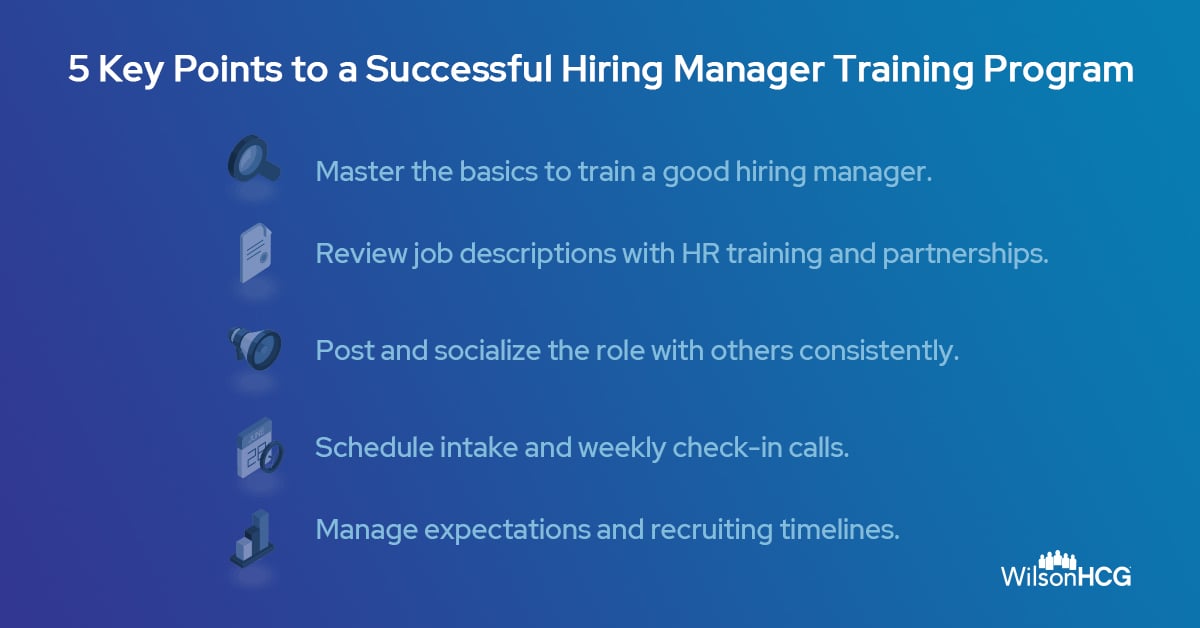5 methods for developing a successful hiring manager training program
April 30, 2021This post was originally published in 2016 and has been updated for stats and relevancy.
When it comes to training to ensure an effective recruitment process, we put a special emphasis on training our talent acquisition teams. After all, they are on the front lines, representing the company and its employer brand, engaging and managing the recruitment process and communicating with both candidates and managers.
While ongoing training is necessary for recruiters and sourcers, it is equally important to train your hiring managers, not only those with the final decision but also those who potentially have the biggest impact on future employees.
What are the five key points to a successful recruitment training program?
#1: Master the basics to train a good hiring manager
When a new hiring manager joins your team or you want to kick up the recruitment training for your current team, you should take time to train them on what the recruitment process looks like from start to finish. If they are working with a recruiter, the specific process for the company and the department should both be reviewed by the recruiter during the initial conversation about the job opening. That doesn’t mean you should wait until then to clue them in on what it takes to go from vacancy to new hire. This includes establishing or informing them of the company employee value proposition or EVP (i.e., what you can offer them in exchange for their time and talents), core company values, employment branding strategy and recruitment marketing strategy.
Read our 2021 Fortune 500 Employment branding report for further insights
#2: Review job descriptions with HR training and partnerships
Reviewing job descriptions for clarity goes a long way toward employee satisfaction and productivity. Employees who experience role clarity are 53% more efficient and 27% more effective at work than employees who have role ambiguity according to Effectory's role clarity fact sheet. While hiring managers should provide content for their job descriptions, it's a good idea to partner with HR or a recruitment professional to ensure clear company culture and information is included as well as a consistent employment brand. Plus, job descriptions need to be optimized for social platforms and mobile devices and reflect the culture and enthusiasm of the hiring team. The employer brand should also be apparent throughout the entire job description, thus requiring a solid understanding of the brand.
#3: Consistently post and socialize the role with others
It is typically the responsibility of talent acquisition professionals to post the position internally or externally, but everyone should be involved in socializing the position. Especially for hard-to-fill positions, the manager hiring the new team member should update their LinkedIn and Twitter profiles to advertise the position and include a link to apply. They can also provide the opportunity to ask questions about the role – and encourage their team members to do the same. Hiring managers should also proactively check in their own networks for potential referrals and encourage their team members to do so as well.
#4: Schedule intake and weekly check-in calls
A hiring manager should expect to have an initial conversation with a recruitment professional to complete a knowledge transfer about the role and the ideal profile. The recruiter typically comes with questions, but the manager in charge should also be prepared to explain the role thoroughly as well as the ideal candidate profile. He or she should also prioritize weekly check-in calls to ensure there aren’t any bottlenecks or unnecessary delays in the process.
#5: Manage expectations and recruiting timelines
While we all want every opening filled yesterday, you need to clearly communicate the typical timeline for filling a position. This will vary depending on industry, company and position, but, in general, you should let the recruiting manager know what steps to expect once the intake call is completed and the job is posted and about how long the following phases will take:
- Sourcing and screening by the recruiter
- Resume submissions
- First-round interviews (typically phone)
- Second-round interviews
- Offer extension and negotiation
- Background checks, reference checks, etc.
- Notices
As HR and talent acquisition professionals, we need to ensure hiring managers are given the training and development needed to both understand their role in the recruiting partnership and to execute it effectively. When this happens, we create a positive candidate experience for everyone as well as a successful final outcome: a strong hire.
Read more content around hiring and recruitment:
The role COVID-19's vaccine will play in hiring in 2021
A "hire" purpose: How your hiring managers can make a strategic difference
Hiring managers: Your secret agents
About WilsonHCG
WilsonHCG is an award-winning, global leader in total talent solutions. Operating as a strategic partner, it helps some of the world’s most admired brands build comprehensive talent functions. With a global presence spanning more than 65 countries and six continents, WilsonHCG provides a full suite of configurable talent services including recruitment process outsourcing (RPO), executive search, contingent workforce solutions, talent consulting and talent intelligence.




